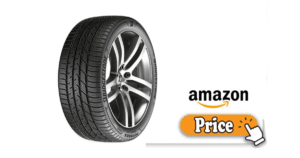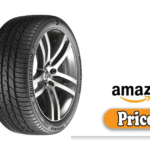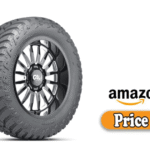When it comes to something as vital as tires, I’ve always believed they’re more than just round pieces of rubber that keep a car rolling. Tires are the only part of the vehicle that actually touches the road, and the quality of that connection determines how safe, smooth, and enjoyable the driving experience is.
Over the years, I’ve tried several brands: Michelin, Goodyear, Continental, and a few budget options. But one brand that has stood out to me time and again is Bridgestone. So, how good are Bridgestone tires really?
That’s the question I kept asking myself before I decided to switch over to them a few years ago. I had read reviews, heard mixed opinions from friends, and even checked out performance stats online.
But nothing really compares to personal experience. After driving with Bridgestone tires across different terrains, weather conditions, and thousands of miles, I finally feel confident enough to give an honest, balanced review.
In this article, I’ll share what I like about Bridgestone tires, what could be better, my personal experiences, insights into their design, performance, and build quality, as well as some alternatives worth considering. By the end, you’ll have a clear picture of whether Bridgestone tires are the right fit for your driving style and needs.
What I Like
There’s a lot I’ve come to appreciate about Bridgestone tires, and it’s not just about marketing hype; it’s about real-world driving results.
1. Wide Range of Options
Bridgestone doesn’t take a one-size-fits-all approach. Whether you’re driving a small sedan, an SUV, or a performance car, there’s a tire line tailored for you. For instance:
- Bridgestone Turanza – focused on comfort and quiet highway cruising.
- Bridgestone Dueler – for SUVs and trucks, designed for durability and light off-road use.
- Bridgestone Potenza – built for sports cars and performance enthusiasts.
- Bridgestone Blizzak – winter tires that handle snow and ice with remarkable grip.
Having this variety means you don’t have to compromise; you can actually pick a tire designed for your exact driving habits.
2. Safety and Grip
This is probably my biggest priority. Bridgestone tires consistently deliver excellent grip, especially in wet conditions. Hydroplaning has always been a fear of mine, and with Bridgestone’s tread design, I noticed much less sliding even in heavy rain.
On dry roads, the traction feels equally reliable, giving me confidence when accelerating, braking, or taking sharp turns.
3. Comfort and Noise Levels
One of the things that surprised me was how quiet Bridgestone tires are compared to some others I’ve tried. Even at highway speeds, the cabin noise felt lower.
That might not sound like a big deal, but on long road trips, reduced tire noise makes a huge difference in fatigue levels.
4. Durability and Longevity
Nobody likes replacing tires every 20,000 miles. Bridgestone tires, in my experience, wear evenly and last longer than budget brands. I’ve had a set of Turanza tires that lasted nearly 55,000 miles with proper rotation and alignment, a strong performance compared to the 35,000–40,000 miles I got from cheaper alternatives.
5. Innovation
Bridgestone is known for being a pioneer in the tire industry. They’ve invested heavily in run-flat technology, eco-friendly rubber compounds, and specialized tread designs. For example, their Ecopia line focuses on fuel efficiency, reducing rolling resistance so your car burns less fuel.
What Could Be Better
Of course, no product is perfect, and Bridgestone tires are no exception. While I’m overall impressed, here are a few areas where I think they could improve:
1. Price Point
Bridgestone tires sit on the higher end of the pricing spectrum. While I personally think the quality justifies the price, I can’t ignore the fact that not everyone can afford premium-tier tires. For budget-conscious drivers, this could be a dealbreaker.
2. Availability of Specific Models
Depending on where you live, certain Bridgestone models (like performance-focused Potenza or specialty Blizzak tires) may not always be readily available.
I had to wait almost two weeks for my Blizzak set during the inter-season demand, which was frustrating.
3. Road Feedback on Rough Surfaces
While Bridgestone tires excel at smoothness and quietness, I noticed that on particularly rough or patched-up roads, some models (especially Turanza) transmit more vibrations into the cabin than expected. It’s not extreme, but compared to Michelin’s Primacy line, I felt a slight difference.
4. Eco-Focused Lines May Sacrifice Grip
The Ecopia line, while excellent for fuel efficiency, doesn’t always provide the same sporty grip as Potenza or Turanza models. It’s a trade-off, but one worth noting if you’re choosing tires with efficiency in mind. 👉🏿👉🏻 Check The Latest Price and Offer at Amazon 👈🏻👈🏿
👉🏿👉🏻 Check The Latest Price and Offer at Amazon 👈🏻👈🏿
My Personal Experience
When I first switched to Bridgestone, I started with the Turanza Serenity Plus on my midsize sedan. I was looking for comfort, longevity, and safety for highway driving. Here’s what stood out to me:
- On my first long drive, about 400 miles, I immediately noticed how much quieter my car felt compared to my old Goodyears.
- Wet-road handling was confidence-inspiring. I drove through heavy rain on the interstate, and the tires cut through standing water without losing stability.
- After about 30,000 miles, the tread wear was surprisingly even. With routine rotations, I got nearly 55,000 miles before I needed a replacement.
Later, I tried Blizzak WS90s on a family SUV during winter. Living in an area with harsh snow, I wanted maximum safety. These were game changers.
Driving uphill in icy conditions, where my previous all-season tires would slip, the Blizzaks gripped like claws. Braking on snow was shorter and more controlled, which gave me peace of mind when driving with kids in the backseat.
On the performance side, I tested the Potenza RE980AS when I briefly owned a sports coupe. These tires hugged corners like glue and delivered precise steering feedback. Yes, they were a bit noisier and wore faster, but for performance enthusiasts, they’re worth every penny.
Design
Bridgestone tires are engineered with purpose. Their designs aren’t just about aesthetics; they’re about function.
- Tread Patterns – Deep grooves for water evacuation, asymmetric patterns for handling balance, and specialized siping for winter grip.
- Rubber Compounds – Bridgestone uses advanced silica blends to enhance both durability and wet traction.
- Sidewall Strength – Run-flat technology allows certain models to keep going for up to 50 miles after a puncture.
- Eco-Designs – Their Ecopia line emphasizes low rolling resistance, which improves fuel efficiency without sacrificing too much comfort.
I’ve always been impressed by how much thought goes into each line. You can tell that a tire for luxury sedans is designed differently from one for sports cars or trucks.
Performance
Performance varies by line, but overall, Bridgestone delivers consistently strong results.
- Dry Roads: Potenza and Turanza excel here, offering precise steering and stability at higher speeds.
- Wet Roads: Bridgestone’s wet grip is among the best I’ve tested. Hydroplaning resistance is a real strength.
- Snow/Ice: The Blizzak line is legendary for a reason. Few competitors match its winter performance.
- Off-Road: The Dueler series is rugged and dependable for SUVs and light trucks, though not extreme off-roaders.
For everyday drivers, Bridgestone balances comfort and reliability well. For enthusiasts, Potenza provides thrills. For safety-focused families, Blizzak is unbeatable.
Build Quality
This is one of Bridgestone’s biggest strengths. Their tires feel solid, from the sidewall to the tread. Even after tens of thousands of miles, the structural integrity holds up. I’ve never experienced premature cracking or bubbling, which I’ve unfortunately seen with cheaper brands.
They also invest heavily in R&D and testing, which is reflected in consistency across their product lines.
Alternative Options
While Bridgestone is excellent, it’s worth considering alternatives:
- Michelin – Often compared to Bridgestone, Michelin excels in comfort and long tread life. Usually slightly pricier.
- Continental – Great all-rounders with strong wet performance and innovative technologies.
- Goodyear – Solid, widely available, with competitive pricing. Their Assurance line is especially good for families.
- Pirelli – Excellent for sporty driving and premium vehicles, though tread life may be shorter.
If you want balance, Bridgestone is hard to beat. If you prioritize comfort, Michelin might be your pick.
Final Thought
So, how good are Bridgestone tires? Based on my honest experience: very good. They aren’t the cheapest, but they offer an excellent blend of safety, performance, and durability.
For drivers who value confidence on the road, whether it’s during a rainy commute, a snowy winter, or a spirited weekend drive, the Bridgestone delivers.
If you’re considering them, think about your driving style. For winter, go Blizzak. For comfort, try Turanza. For performance, Potenza is your friend. For SUVs, Dueler works great. And if fuel efficiency is your priority, Ecopia has you covered.
In short, Bridgestone tires are worth the investment if you value quality and peace of mind.
Read More: Mickey Thompson Tires Near Me
FAQs: How Good Are Bridgestone Tires | My Honest Experience
Q1: Are Bridgestone tires better than Michelin?
It depends. Michelin tends to last longer and be quieter, but Bridgestone often offers better wet grip and winter performance, especially with their Blizzak line.
Q2: How long do Bridgestone tires last?
With proper care, most Bridgestone tires last between 50,000–70,000 miles, depending on the model and driving conditions.
Q3: Are Bridgestone tires good for snow?
Yes, if you pick the Blizzak line. These are specifically designed for snow and ice, offering exceptional grip.
Q4: Do Bridgestone tires make noise?
Most are relatively quiet, especially the Turanza line. Performance-oriented models like Potenza may produce more road noise.
Q5: Are Bridgestone tires worth the price?
If safety, durability, and performance are priorities, yes. They cost more than budget brands, but the peace of mind is worth it.
Q6: Which Bridgestone tire is best for SUVs?
The Dueler line is the most popular for SUVs, offering durability and light off-road capability.
Q7: Do Bridgestone tires improve fuel efficiency?
Yes. The Ecopia line is designed to reduce rolling resistance, which can improve mileage by 3–5%.
Q8: Are Bridgestone tires run-flat?
Some models include run-flat technology, particularly for luxury and performance cars. These allow you to drive up to 50 miles after a puncture.
Q9: Are Bridgestone tires good for off-roading?
The Dueler series handles light to moderate off-road conditions, but hardcore off-roaders may prefer brands like BFGoodrich.
Q10: Should I choose Bridgestone for everyday driving?
Absolutely. Bridgestone offers a balance of safety, comfort, and reliability for daily use, making them a strong choice for most drivers.




